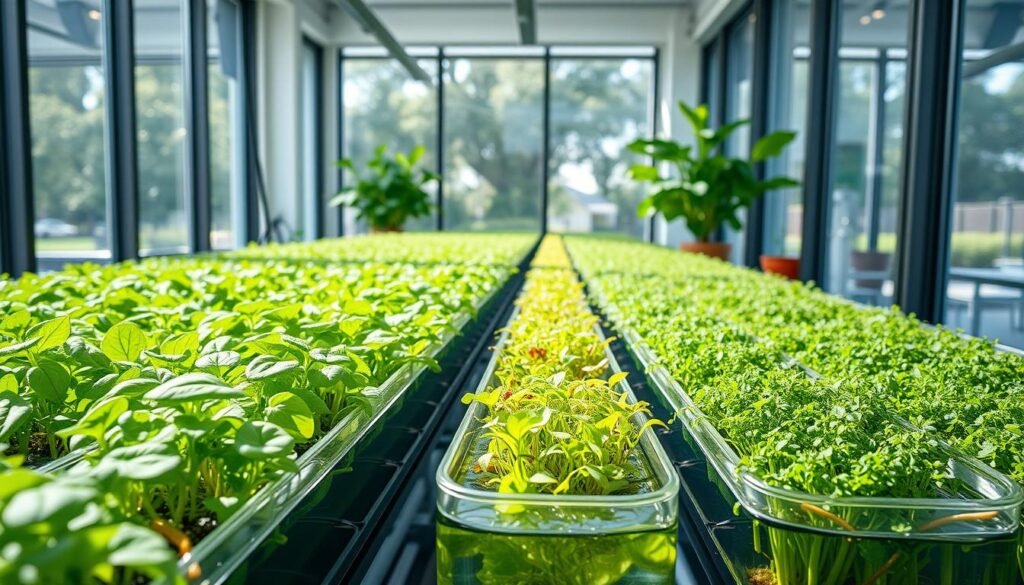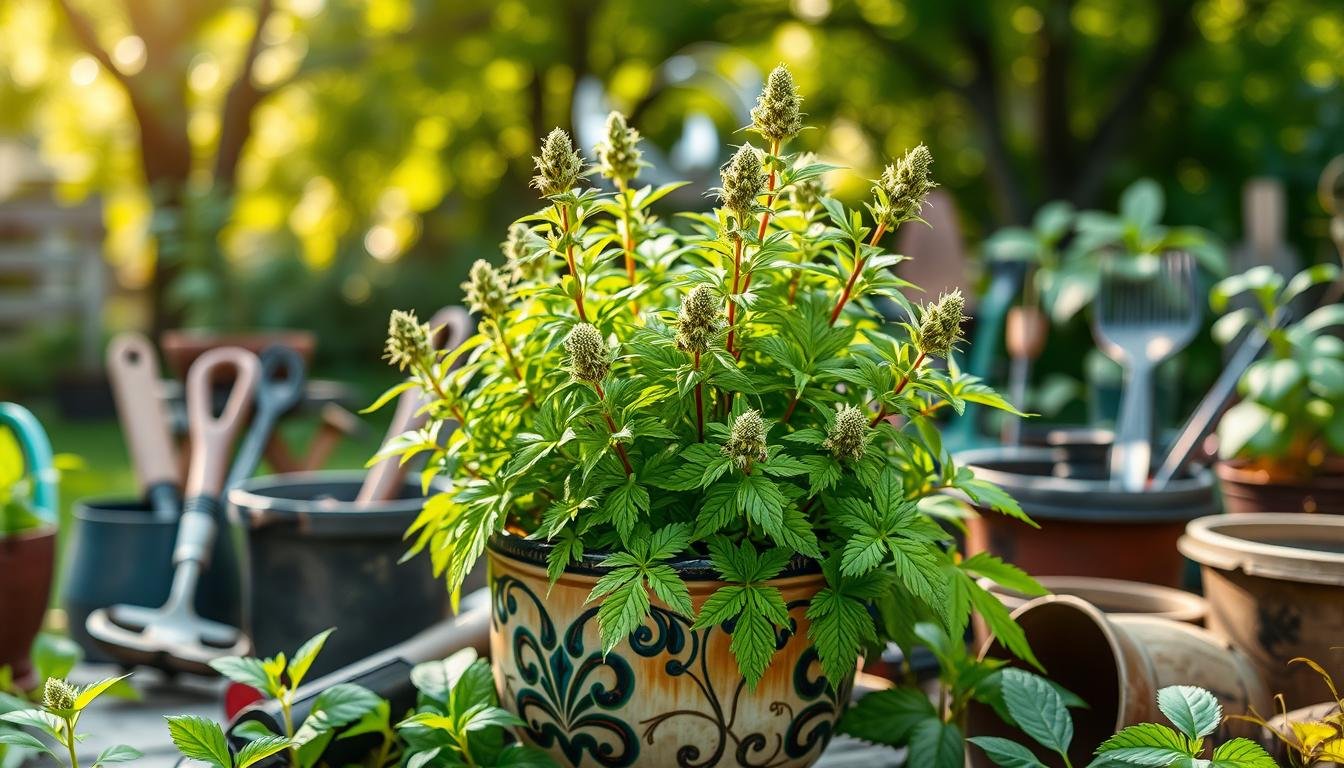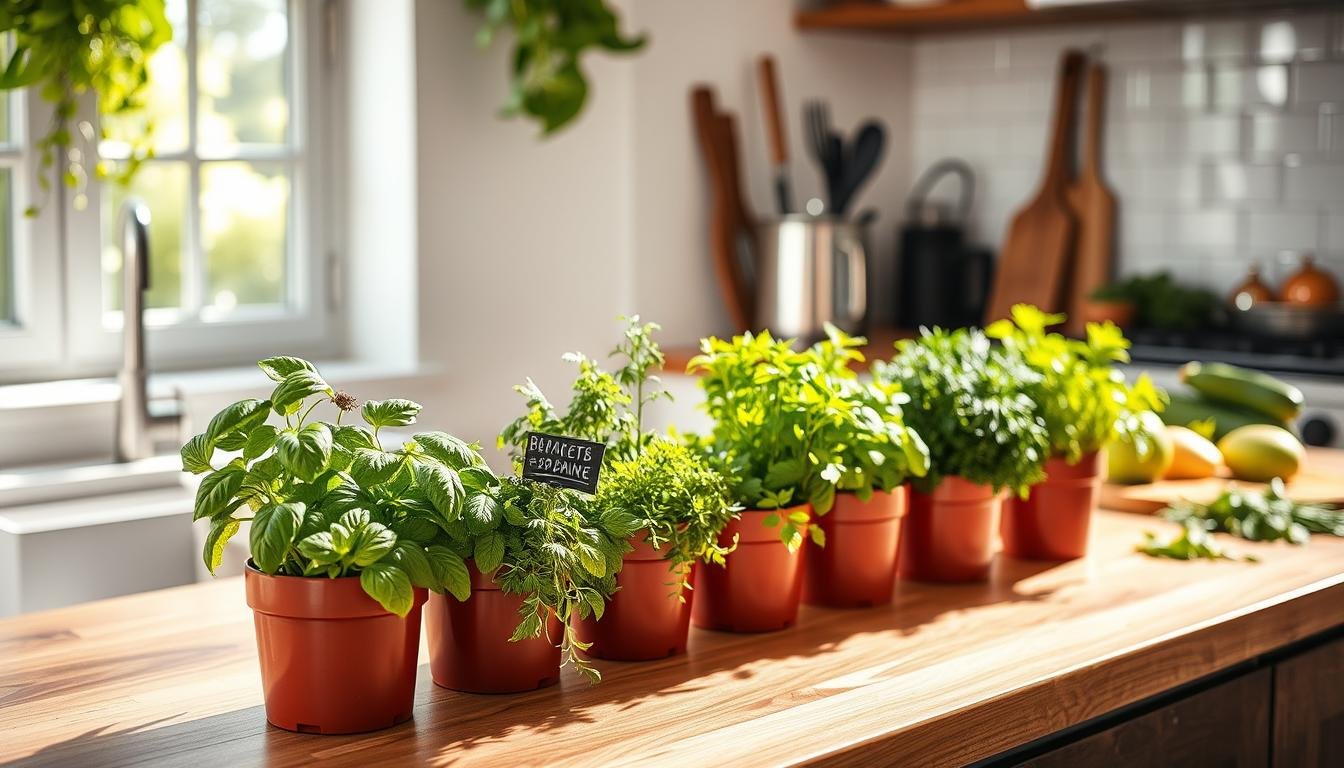Did you know that by 2026, the microgreens market might hit $2 billion? This shows their growing popularity among food lovers and health buffs. More folks now seek ways to grow plants sustainably, raising interest in soil-free microgreen cultivation. Such methods, like hydroponics and aeroponics, save space and boost nutrient absorption.
This guide dives into the perks of soilless microgreen farming, focusing on hydroponics and aeroponics. These techniques offer better control of growing conditions and use resources efficiently. Perfect for city dwellers and those keen on indoor farming. Discover the tips for a successful microgreens garden that can thrive anywhere!
Key Takeaways
- Microgreens are young edible plants packed with nutrients.
- Growing microgreens without soil opens up possibilities for indoor and urban gardening.
- Hydroponic systems provide efficient nutrient delivery and space optimization.
- Aeroponic microgreens require minimal water and maximize oxygen exposure.
- Soilless cultivation methods are ideal for sustainable and sustainable gardening practices.
Introduction to Microgreens
Microgreens are young plants you can eat, picked just after their first true leaves appear. These small greens are nutrient-rich and tasty. They are perfect for those who care about health. Favorites like arugula, radish, and basil are popular for their unique flavors and bright colors. They bring freshness to many meals.
Growing microgreens without soil is easy, making them great for everyone. Even if you’re new to gardening or have lots of experience, you can grow them. They need little space and not many resources. This makes them ideal for people living in cities or anyone who doesn’t have much room for gardening.
Microgreens are more nutritious than the adult plants they grow from. Research shows they have more vitamins and minerals, which is great for your health. They can make salads, sandwiches, and smoothies more nutritious and tasty. This is why microgreens are becoming so popular in cooking today.
In short, microgreens combine delicious flavors, health benefits, and ease of growing. They inspire many to use them in cooking and to try growing them.
Benefits of Growing Microgreens Without Soil
Growing microgreens without soil has many upsides for both home gardeners and commercial growers. These benefits go beyond simple convenience. One big plus is how fast they grow in a soilless setup. Many types can be ready to pick in just two weeks. This means quick profits for growers.
They also don’t need much room. This makes them perfect for cities where space is tight. With the right setup, lots of microgreen trays can fit indoors or on rooftops. Even small spaces become productive green areas.
Keeping things clean in production is a big win. Without soil, there’s less chance for diseases from the soil to attack young plants. This method leads to healthier plants and cuts down on the need for harmful chemicals.
Nutrient uptake is better and easier to control without soil. Growers can adjust nutrients exactly as needed, which can lead to more crops. This way supports growing microgreens with less waste and less use of resources.
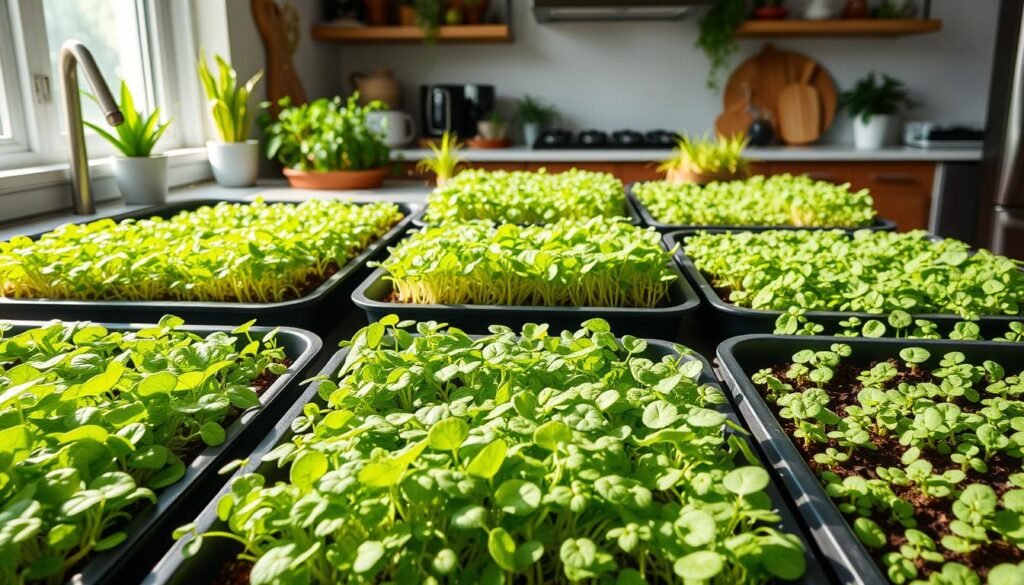
Last, growing microgreens this way is good for our planet. It uses less water, important in dry areas. It also avoids strong farm chemicals, making the food we eat safer. By growing microgreens without soil, growers do good for both our health and the earth.
Understanding Hydroponic Microgreens
Hydroponic microgreens grow without soil, using nutrient-rich water instead. This method boosts their growth and nutritional value. By understanding how hydroponics works, you can grow many types of microgreens more efficiently.
Basics of Hydroponic Systems
Hydroponic setups give plants their nutrients directly through water, making soil unnecessary. There are various systems for growing microgreens without soil, including:
- Wick Systems: These are simple and affordable, using a wick to soak up the nutrient solution.
- Deep Water Culture: Here, roots hang in a nutrient solution, getting plenty of oxygen and minerals.
- Nutrient Film Technique (NFT): This method has a constant flow of nutrients over the roots, for perfect moisture and nutrition.
Choosing the Right Hydroponic Setup
It’s important to pick the right hydroponic setup for growing microgreens. Things to think about include:
- Space: Know how much room you have for your setup.
- Budget: Look at the cost of different systems to find one that suits your wallet.
- Microgreens Variety: Some systems work better for certain types of microgreens. Pick accordingly.
Each hydroponic system has its perks, like being easy to use or able to grow more plants. Also, having the right equipment, like grow lights and pH meters, is key to success. Quality tools lead to better growth and more fun in gardening.
| Hydroponic System | Advantages | Best for |
|---|---|---|
| Wick Systems | Low-cost and simple setup | Beginners |
| Deep Water Culture | Fast growth rates, excellent oxygen access | Leafy microgreens |
| Nutrient Film Technique (NFT) | Efficient use of nutrients and water | Commercial production |
Exploring Aeroponic Microgreens
Aeroponic microgreens are a new way to grow plants without soil. In this method, plant roots hang in the air. They get sprayed with a special nutrient solution regularly. This helps the plants to grow well without soil.
The Aeroponic System Explained
Aeroponic systems have many parts that work together. Some important parts are:
- Misting Nozzles: These spray the roots with a nutrient mix.
- Nutrient Reservoirs: These hold and send the nutrient mix to the plants.
- Growth Chamber: This is where the plants grow, getting enough light and air.
These parts help aeroponic systems grow microgreens faster and better.
Advantages of Aeroponic Growing
Aeroponic growing has many benefits. Some of the main ones are:
- Greater Oxygen Availability: Roots get more oxygen, which helps them grow faster.
- Less Risk of Disease: No soil means fewer diseases from fungi.
- Water Conservation: These systems use much less water than traditional methods.
- Energy Efficiency: They’re made to use resources well, which is great for growing microgreens in cities.
This way of growing is good for farmers and the environment. It’s a sustainable choice for growing microgreens without soil.
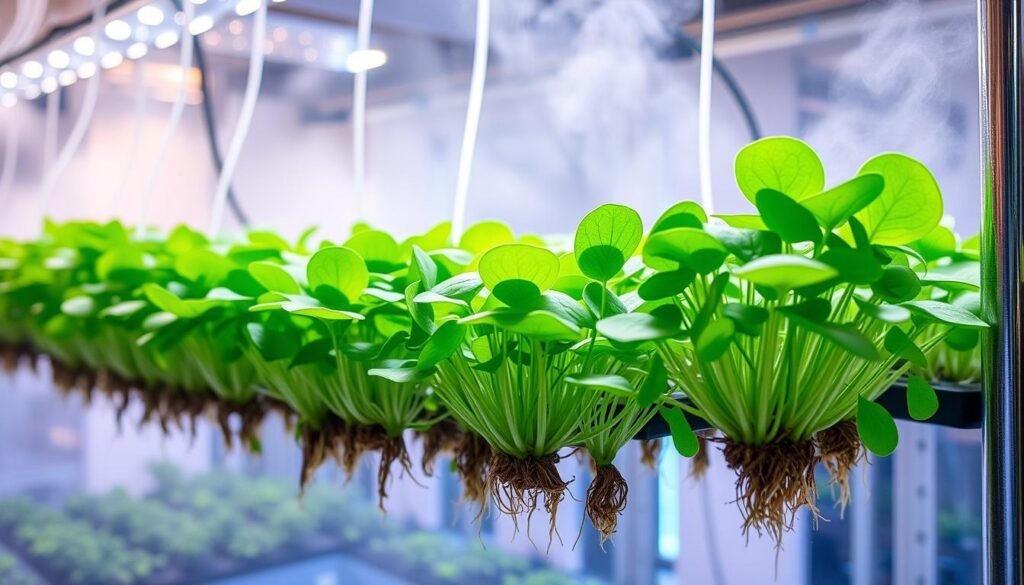
Essential Nutrients for Soilless Microgreens
Growing soilless microgreens is both challenging and rewarding. Knowing the right nutrients is key for their growth. These nutrients come from systems like hydroponics, focusing on nutrient delivery.
Microgreens need macronutrients to grow well. The main ones include:
- Nitrogen: Important for the growth of leaves.
- Phosphorus: Helps with roots and flowers, making strong roots without soil.
- Potassium: Improves water uptake and enzyme work.
Micronutrients are also critical for healthy microgreens. Key micronutrients are:
- Iron: Crucial for making chlorophyll, which keeps leaves green and healthy.
- Calcium: Makes cell walls strong, supporting the plant’s structure.
- Magnesium: Part of chlorophyll, it helps with photosynthesis.
Keeping the nutrient solution’s pH right is vital. The best pH for microgreens is between 5.5 and 6.5. This range makes sure plants get all nutrients they need, leading to strong growth.
Test and adjust your nutrient solution regularly. Knowing and using the right nutrients makes growing soilless microgreens successful. With good nutrient delivery methods, you can grow thriving plants.
| Nutrient Type | Example Nutrients | Benefits |
|---|---|---|
| Macronutrients | Nitrogen, Phosphorus, Potassium | Supports growth, root development, and overall health. |
| Micronutrients | Iron, Calcium, Magnesium | Enhances photosynthesis, cell structure, and nutrient transport. |
| pH Control | Testing Kits | Maintains ideal nutrient availability. |
Step-by-Step Guide to Growing Microgreens Without Soil
Growing microgreens without soil is exciting for both enthusiasts and beginners. This guide will help you from choosing the right seeds to setting up the perfect environment.
Choosing Seeds for Microgreens Cultivation
Choosing the right seeds is crucial for growing microgreens. Let’s focus on key aspects:
- Flavor and Nutritional Value: Pick seeds known for strong flavor and high nutrients. Radish, broccoli, and sunflower are great choices.
- Germination Rate: Go for seeds that have a high chance to sprout. This ensures better yields.
- Reputable Suppliers: Buy seeds from trustworthy sources like Johnny’s Selected Seeds or High Mowing Organic Seeds. It lowers the risk of getting poor or old seeds.
Preparing Your Growing Environment
Creating the right environment is important for strong, healthy microgreens. Keep these factors in mind:
- Lighting: Ensure your plants get enough light, about 12-16 hours a day. Place grow lights 2-4 inches above the plants.
- Temperature: Keep the area at 65-75°F for the best growth. Steer clear of big temperature changes to avoid plant stress.
- Humidity: A moderate humidity level (40-60%) helps with germination. Consider a humidity dome for the first few days if needed.
Using the right approach when growing microgreens without soil improves their flavor and growth. Here’s a table of essential conditions for a good microgreen environment:
| Requirement | Optimal Range |
|---|---|
| Light Duration | 12-16 hours |
| Temperature | 65-75°F |
| Humidity | 40-60% |
Indoor Microgreen Gardening: Techniques and Tips
Growing microgreens indoors is a great way to get nutrient-packed greens in small spaces. You don’t need a big garden to start. Different methods can make your indoor gardening fun and lessen common problems found in soilless microgreen growing.
Using vertical gardening saves space brilliantly. Wall-mounted planters or shelves work well. Windowsills are great for getting sunlight, and grow tents offer control over the growth environment. This control helps keep temperature and humidity just right.
How you water your microgreens is key. A self-watering system keeps moisture levels steady. It’s also crucial to feed them right. Try hydroponic solutions for soil-free nutrients. And keep an eye on pH levels for healthy plants.
When growing microgreens without soil, avoid putting too many seeds together. Not enough light can make plants weak. Rotate your trays to give them even light. With these tips, you’ll have a lush indoor microgreen garden.
| Technique | Description | Benefits |
|---|---|---|
| Vertical Gardening | Utilizing wall-mounted planters or shelves | Maximizes small spaces for growth |
| Window Sills | Growing microgreens in natural light | Easy access and excellent light exposure |
| Grow Tents | Controlled growth environment | Makes it easier to manage temperature and humidity |
| Self-Watering Systems | Automates the watering process | Ensures consistent moisture levels |
| Hydroponic Solutions | Nutrient-rich solutions for growth | No soil required, promoting healthier plants |
Urban Microgreens: Sustainable Practices
Urban microgreens farming introduces innovative sustainable microgreens production methods. It uses small spaces well and tackles urban food issues. By growing microgreens in cities, food miles drop, leading to a greener food system.
In many cities, urban microgreens projects boost local farming partnerships. These partnerships help residents learn to grow microgreens farming in places like backyards or rooftops.
- Utilizing recycled materials for growing containers
- Implementing water-efficient hydroponic systems
- Incorporating local composting methods to enrich soil
- Participating in local farmers’ markets to connect with consumers
Urban microgreens farming does more than grow food. It also improves air quality and adds green areas. This makes crowded places nicer to live. With proper techniques and support, any city area can be a center for sustainable microgreens farming.
| Aspect | Urban Microgreens Farming | Conventional Farming |
|---|---|---|
| Space Utilization | Efficient use of rooftops and small plots | Requires larger fields |
| Food Miles | Minimal, often local | Higher due to transport distances |
| Community Involvement | High, with local workshops and initiatives | Low, often reliant on larger corporations |
| Environmental Impact | Positive due to reduced emissions | Can lead to soil depletion and pollution |
Getting involved in urban microgreens farming helps the local economy. It also builds a community that cares about eco-friendly practices.
Nutrient Film Technique for Microgreens
The nutrient film technique microgreens method is a smart way to grow greens without soil. It uses a thin stream of water full of nutrients that flows over the roots. This gives the plants all they need for growth and uses less water.
- Nutrient reservoir: Holds the nutrient solution.
- Pump: Circulates the nutrient solution through the system.
- Growing trough: Where microgreens are planted and the nutrient film flows over their roots.
- Drainage system: Collects excess nutrient solution returning to the reservoir.
For success, it’s key to keep up with maintenance. Check the nutrient levels, pH balance, and cleanliness regularly. And, adjust nutrient concentrations to fit the crop being grown.
Some soilless microgreens do better than others with NFT. Great choices include:
- Basil
- Radish
- Mustard greens
- Pea shoots
These plants grow fast and adapt well to the system. The right light and temperature will help them grow even better in hydroponics.
| Microgreen Variety | Growth Duration (Days) | Nutrient Needs |
|---|---|---|
| Basil | 10-14 | Moderate |
| Radish | 7-10 | Low |
| Mustard Greens | 7-12 | Moderate |
| Pea Shoots | 14-21 | Moderate |
With the nutrient film technique microgreens method, growers can build a strong and effective system. This method promotes the growth of healthy and tasty greens in hydroponic systems.
Common Challenges in Microgreen Farming
Trying to grow microgreens without soil can be rewarding. Yet, it has its challenges. First, there’s the issue of dealing with pests. Aphids and spider mites love the warm, controlled environments of hydroponic systems. They can quickly ruin your crops. Checking your plants often and using natural pest control can help fight these pests.
Diseases are another big problem in farming microgreens. Fungal diseases like damping-off thrive in wet conditions. It’s very important to keep the air humidity just right. Making sure there’s enough air flow and space will keep your microgreens healthy without soil.
Controlling the environment is tough for growers, too. Changes in light, temperature, and water can affect how well microgreens grow. To manage these issues, it’s smart to invest in a good growing system. This system should let you watch and adjust conditions as needed. By solving these common problems, you can have a great harvest. And your microgreens will taste as good as they look.
